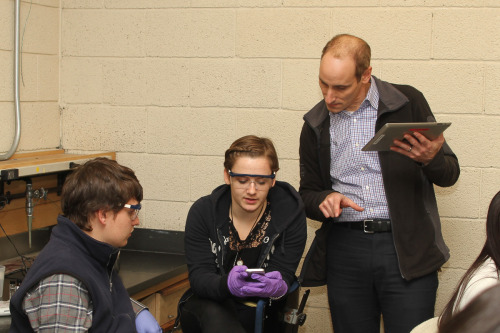
Student- Driven instruction in Harvard’s laboratory setting
Guest Blogger Pamela Levine sat down with Education Science Programs and Curriculum Specialist at Harvard Medical School, Robert Simpson to learn more about Harvard Medical School’s Advanced Placement (AP) Biology Hinton Scholars Program.
Harvard Medical School’s Advanced Placement (AP) Biology Hinton Scholars Program is an after-school enrichment program serving 85 high school sophomores, juniors, and seniors from Boston Public Schools. The program combines tutoring, mentorship, and biology laboratory experiences to increase students’ understanding of AP Biology concepts and expose them to careers in the sciences. For the past two years, the Hinton Scholars Program has been using student responses and work in Nearpod to inform instruction in a laboratory setting.
Q: How did you get started with Nearpod?
SIMPSON: Nearpod was on my radar from an ISTE conference a few years ago. I started asking the question, “how many high school students in Boston Public Schools have mobile devices?” It turns out that a majority of them do. (For this program year, 95% own a smartphone & 45% own a tablet) Nearpod is definitely solving a problem that I see, where the public schools are so overwhelmed with what they need to do to get students through testing, that they’re not thinking about how to use these mobile devices students are bringing to school for teaching and learning. We are saying yes to mobile devices for teaching and learning.

Q: How is Nearpod used in the AP Biology Hinton Scholars Program?
SIMPSON: The challenge for us is that we don’t control the students’ curricular experiences through the whole school day—they’re coming in after school. A lot of the time, graduate student and postdoc volunteers don’t know what the students have reviewed in the past couple weeks, so there’s a big question: “do they know this or not?” You can be in a room with students and say, “so what do you want to know?” but it’s a lot more powerful to say “turn on Nearpod, I’ve got a few questions for you that align to today’s topic in the lab.”
We have a probeware system and it uses a concentration measurement. The assumption is that everyone has read the materials and knows the term, ‘concentration.’ But if students don’t actually know what it means, then when they get in the lab they’re at a real disadvantage. So we’ll simply ask in Nearpod before they get in the lab, “can you define this term?” Sometimes the students have read about it, but they don’t really know it. So we use Nearpod to reinforce what they really should know.
We also have a program where any teacher in Boston Public Schools can sign up and bring their class for one lab session. For those students, we really don’t know what their background is. Before they get into the lab, we need to know some basics about their motivation, their familiarity with the overall framework of AP biology and with that particular lab topic. That helps us inform the instruction.
We use Nearpod embedded in both the tutoring and the lab experiences, and students are using their own devices to access Nearpod on Harvard Medical School Wifi. When students come in, we want them to be on task. Launching Nearpod is their cue to get on task. Nearpod is also a way of exposing students to technologies that they are most likely to see going forward. In addition to AP Biology, we are also trying to prepare them for college and for majoring in health careers and STEM fields.
We are big fans of professor of physics, Eric Mazur. Back in the ‘90s, he was trying to figure out why he was having trouble with getting students to communicate their understanding (as opposed to simply regurgitating information) and developed a collaborative teaching method called Peer Instruction. That’s the theoretical foundation for why we do some of these things. When students pair up, they discuss the questions and content—they go back and forth—and that’s exactly what we want to have happen.

Q: How do you work with the Harvard medical and graduate student tutors to coordinate this approach?
SIMPSON: Last year, I gave a simulated classroom experience where I demonstrated the Nearpod technology, taught the pedagogy, addressed what we want to try out and why. A lot of the tutors gravitated towards it, primarily because this was a way of getting some insight into where students are. Some of my tutors are now “powerusers.”
I create basic skeletons of Nearpod lessons that cover just the basics of what we want to accomplish. I then push that out to my powerusers, and they take it, adapt it, and share with each other. Some of my tutors have other teaching responsibilities at Harvard. This has opened their eyes to potentially using this tool in their other teaching ventures.


Nearpod’s award-winning platform is used by thousands of schools around the globe, transforming classroom engagement.








